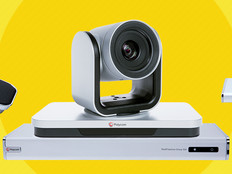How Video Collaboration Between Hospitals Improves Patient Care
Physicians from University of California Davis Children’s Hospital in Sacramento can provide remote critical care to infants and children who would otherwise have to travel hundreds of miles for treatment — and it’s all thanks to video.
“If children are sick at 3 a.m. in a medical emergency, my colleagues and I can see them virtually by their bedside, read images, interpret laboratories and help direct therapies remotely,” says Dr. James Marcin, a professor of pediatric critical care and director of the UC Davis Pediatric Telemedicine Program.
Using encrypted, high-definition (HD) video, specialists participating in the program connect with remote healthcare providers spread across 33 counties in the state. The real-time consults — which average 2,800 per year — are vital to rural communities for which UC Davis is the only comprehensive children’s hospital within several hours’ drive.
“We’re saving kids’ lives,” Marcin says.
Telemedicine Takes Off
Although UC Davis was an early adopter of telemedicine, having used video conferencing for the past 15 years, hospitals across the country have begun deploying the technology: In 2017, 35.3 percent of healthcare providers are expected to invest in telemedicine, telehealth or connected health technologies to support transformative initiatives, according to an IDC Health Insights survey.
Lynne Dunbrack, research vice president for IDC Health Insights, says telemedicine growth is driven by the shift from fee-for-service to value-based healthcare, as well as the emphasis on the Institute for Healthcare Improvement’s Triple Aim goals: reducing per capita healthcare costs, improving population health and enhancing the patient experience of care.
Video conferencing has potential to further those aims by allowing patients to experience timely care without having to travel long distances to see specialists. The technology can also cut travel costs for healthcare providers while improving communication and creating more efficient workflows.
A physician following up with a recently discharged patient, for example, can conduct a brief video consultation, rather than holding an in-person appointment. Marcin says virtual visits like that can cut down on administrative tasks like checking the patient in, taking vitals and placing the patient in a room — all for a 10-minute checkup.
“Such visits can be done quickly and efficiently, and even in the patient’s own home, if the patient is doing well,” he says.
Building a Backbone for Innovation
While the benefits of telemedicine are clear, hospitals and clinics need to prioritize several key technologies to ensure their investments pay off.
According to Dunbrack, it’s important to have fast broadband access and a secure, robust network that ensures good quality of service for HD video. Healthcare providers also need to identify video equipment that integrates with electronic health records and can transmit medical images and diagnostic tests, she adds.
Marcin says the telemedicine program at UC Davis takes advantage of a range of technologies, all compliant with the Health Insurance Portability and Accountability Act (HIPAA). Specialists connect with healthcare providers using simple notebook webcams and microphone headsets. Doctors in remote emergency rooms, on the other hand, rely on high-end HD video conferencing units with audio capabilities. Their equipment features 20X optical pan-tilt-zoom lenses that allow providers to inspect their young patients and then pan out to talk to parents, Marcin says.
Marcin adds that while the cost of video conferencing equipment was once a significant barrier to instituting a telemedicine program, that obstacle is shrinking.
“The equipment over time has gotten better and less expensive,” he says.








